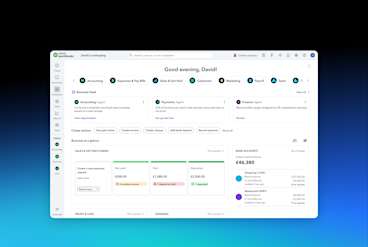
Cloud accounting
Automation vs AI vs Agentic: What every accountant should know
Simple, smart accounting software - no commitment, cancel anytime

TAX AND PENSIONS
Navigating tax residency can be challenging, especially when your income spans international borders. Whether you're an individual or a company which has activities abroad, the income you earn is subject to taxation.
To avoid the complexities of paying taxes in two separate locations, it’s important to obtain a Tax Certificate of Residence from His Majesty’s Revenue and Customs (HMRC) if you’re a resident of the United Kingdom. This document not only proves your residency in the United Kingdom but also opens avenues for claiming tax relief in other countries.
The UK Tax Certificate of Residence is a document relating to international transactions that is issued by His Majesty’s Revenue and Customs (HMRC). This certificate acts as tangible evidence of an individual or business’s residency in the United Kingdom.
This lays the foundation for claiming tax relief in foreign jurisdictions, particularly under double taxation agreements.
To qualify for this certificate, individuals or businesses must meet specific criteria. This includes being a resident in the UK, having a double taxation agreement in place, or seeking a refund for taxes previously paid.
The application process varies for different entities, depending on whether you are an individual, business, partnership, trust, or other. Regardless, successful applicants will need to provide comprehensive information to substantiate their claim.
When applying for a Certificate of Residence from HMRC, you need to provide specific and detailed information to support your claim. The required information includes:
Purpose of Certificate:
Clearly articulate why you need the Certificate of Residence and specify any relevant double taxation agreements under which you intend to make a claim.
Details of Relevant Income:
Provide information about the relevant income for which you are seeking the certificate. This involves specifying the nature of the income and demonstrating its connection to the UK tax system.
Period of Residence:
Clearly state the period for which you require the Certificate of Residence. This period is often referred to as the tax certificate period.
Beneficial Ownership Proof (if required):
Should the double taxation agreement require it, you’ll need to provide evidence that you are the beneficial owner of the income for which you are filing a claim. Additionally, confirm that all income subject to the claim is subject to UK tax.
Residence Test Information:
If applying for a Certificate of Residence in the UK for a period beginning on or after April 6, 2013, and you haven't submitted a Self Assessment tax return for that period, you must inform HMRC of the number of days spent in the UK during the tax year.
Arrival and Departure Information:
Provide details about your arrival or departure date in the United Kingdom. If you entered or left the UK during the tax year, specify the date for which you need the certificate.
Authentication Form or Apostille (if required):
Depending on the circumstances, you may need to obtain an authentication form or apostille, often involving a nominal charge to the Financial Conduct Authority (FCA). This step is essential for legally admissible documents.
It’s important to remember that the application process for the tax residency certificate will vary depending on what your circumstances are. With this in mind, let’s explore three separate types of application:
One of the most common types of entity applying for a certificate of residence is a sole trader. If you are a sole trader seeking to apply, here are some steps that you could follow:
Online Application:
Utilise your Government Gateway user ID and password to apply online. This method is a convenient and efficient way for sole traders to begin the application process.
Form Submission by Email:
Alternatively, sole traders can opt to submit the required form by email. It's essential to create a new User ID if one doesn't already exist. If an agent is applying on behalf of the sole trader, the same approach should be followed.
Submission of Forms from Other Governments:
If the application involves forms from other governments requiring certification of residency status, you can submit this to the specified address. This is the HMRC at BX91AS.
Provide Comprehensive Information:
Clearly state the purpose of the Certificate of Residence, specifying any applicable double taxation agreements. Sole traders must also supply detailed information about the relevant income, the tax certificate period, and, if necessary, evidence of beneficial ownership.
Residence Test Information (if applicable):
If applying for a certificate for a period starting on or after April 6, 2013, and no Self Assessment tax return has been submitted for that period, sole traders need to inform HMRC of the number of days spent in the UK during the tax year.
Limited companies applying for a Certificate of Residence have a different application process to sole traders. If this applies to you, here are some steps that you could follow:
RES1 Form for Letter Requests:
Limited companies must use the RES1 form when making letter requests for a Certificate of Residence. This form serves as the official request for the certificate.
Submission to Customer Compliance Manager:
The completed letter request using the RES1 form should be sent to the customer compliance manager who oversees the company's tax affairs. Alternatively, the request can be directed to the corporate tax services office if they are responsible for the company's tax affairs.
Submission Address:
Send the letter request, typically the RES1 form, to the designated address, which may include the customer compliance manager or corporate tax services office. The specific address for submission is often indicated on the form.
Email Requests for Large Companies:
In the case of larger companies with a customer compliance manager or customer coordinator, email requests can be directed to them instead of using the postal address (BX91AS HMRC).
Compliance with HMRC Guidelines:
Ensure that the application adheres to HMRC guidelines for certificate requests, providing all necessary information about the purpose, relevant income, tax certificate period, and any required evidence of beneficial ownership.
Authentication Form or Apostille (if required):
If required, obtain an authentication form or apostille by paying the necessary fee to the Financial Conduct Authority (FCA). This step is crucial for ensuring the legal admissibility of documents.
Detailed Information Submission:
Include comprehensive details about the purpose of the certificate, relevant income, and any other information required by HMRC to support the application.
While the tax residency certificate application process for partnerships is similar to limited companies, there are some differences. The steps for partnerships are as follows:
RES1 Form for Letter Requests:
Partnerships can use the RES1 form when making letter requests for a Certificate of Residence. This form is designed for partnership firms and serves as the official request for the certificate.
Customer Compliance Manager or Coordinator:
Submit the completed RES1 form, typically a letter request, to the customer compliance manager or customer coordinator. If the partnership is part of a larger company, these requests should be directed to the designated individuals within that company.
Email Requests to Designated Individuals:
Larger partnership firms with customer compliance managers or coordinators may choose to send email requests to these designated individuals, as opposed to using the postal address (BX91AS HMRC).
Compliance with HMRC Guidelines:
Ensure that the application aligns with HMRC guidelines for certificate requests. Provide all necessary information about the purpose, relevant income, tax certificate period, and any required evidence of beneficial ownership.
Authentication Form or Apostille (if required):
If necessary, obtain an authentication form or apostille by paying the required fee to the Financial Conduct Authority (FCA). This step is vital for ensuring the legal admissibility of documents.
Submission Address:
Send the letter request, usually the RES1 form, to the designated address, which may include the customer compliance manager or coordinator. Specific submission details are often provided on the form.
Detailed Information Submission:
Include comprehensive details about the purpose of the certificate, relevant income, and any other information required by HMRC to support the application.
If you need further guidance around this, or do not fit these three entity types, follow the specific guidelines provided by HMRC for your entity type to aid you further.
QuickBooks is your go-to solution for seamless HMRC administration. Streamline tax returns, track VAT effortlessly, and get real-time income tax estimates with our intuitive tax software.
With user-friendly features, automation, and free technical support, QuickBooks will help you in managing certificates of residence and ensuring compliance with confidence. Try QuickBooks today for a hassle-free financial experience.
The processing time for your application may vary, with it typically taking around two to three weeks. However, the duration can be influenced by factors such as the complexity of your application and whether additional information or documents are required.
To prove tax payment in the UK, you can submit your self-assessment tax return, maintain records of tax payments like receipts or bank statements, and provide official documents such as P60 or P45 forms.
Employment income records and tax certificates from HMRC can also serve as evidence.
Subscribe to get our latest insights, promotions, and product releases straight to your inbox.
9.00am - 5.30pm Monday - Thursday
9.00am - 4.30pm Friday